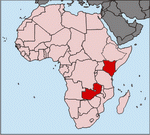History:
The genus Pterinochilus was established by Reginald Innes POCOCK in 1897 on basis of a male P. vorax. The habitat of the holotye is Fwambo (at the lake Tanganyika) in the western parts of Tanzania. In the same work described POCOCK a semiadult male of P. murinus. In 1878, 19 years afore POCOCK, Ferdinand Anton Franz KARSCH (*1853 - †1936) described Harpactira elevata which turned out by Richard C. GALLON in 2002 to be a senior synonym of P. murinus. R. LAURENT synonymised in 1946 the genus Pterinochilides STRAND, 1920 with Pterinochilus POCOCK, 1897.
The most important modern paper about the genus are the book "Baboon Spiders" written by A.M. SMITH in 1990 and the revision of the genera Pterinochilus and Eucratoscelus by R.C. GALLON published in 2002. After this revision the once numerous genus with 22 species shrunk to clear 6 species. Also in 2002 Dr. Günther SCHMIDT described P. leetzi. The genus enfolded at the moment 7 species.
The mainarea of circulation is middle and east Africa.
Key features of the genus:
- Fovea transverse or slightly procurved
- Scopulae on the chelicerae retrolateral present (s. P. chordatus
 )
) - Scopulae on the chelicerae prolateral absent (s. P. lugardi
 )
) - Chelicerae with numerous long emergent setae
- small upt to large Harpactirinae (female: ~20-60mm, male: ~20-50mm)
- Distal segment
of posterior spinneret digitiform (Fig. 108
 )
) - Tarsal scopulae undivided (s. P. chordatus
 )
) - Metatarsal scopulae on leg I, II and III undivided (s. P. chordatus
 )
) - Metatarsal scopulae on leg IV bisected longitudinally by band of stiffened setae (s. P. chordatus
 )
) - Spermathecae paired
Species:
| Pterinochilus alluaudi BERLAND, 1914 | |
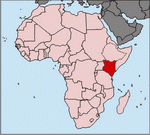 |
Distribution: Kenya Coloration: Uniformly pale brown. Leg and palp joints are pale yellow. Carapace with golden radial striae. Dorsum of abdomen with indistinct pattern of dark bars and spots. Fovea: transverse Spermathecae: unkown Palpal bulb: pyriform with thick squat embolus. Embolus with distinct triangular cross section with three keels (prolateral superior, prolateral inferior and apical), one at each angle. (Figs. 97 Body length: male 28mm, female unknown |
| Pterinochilus chordatus (GERSTÄCKER, 1873) | |
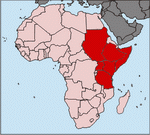 |
Distribution: Ethiopia, Kenya, Somalia, Sudan, Tanzania and Uganda Coloration: Legs, palpi and chelicerae beige, grey or black depending of colouration variant or duration since last moult. Leg and palp joints are pale yellow. Carapace beige, grey or black with golden radial striae (striae sometimes very or absent). Dark "mask" around the ocular tubercle. Dorsum of abdomen beige, grey or black with dark pattern of bars, spots and reticulations (pattern in DCF obscure) - general colouration can vary addicted on the colour variation. Fovea: transverse Spermathecae: slightly medial constricted without terminal lobs. Usually splayed outwards (Figs. 105 Palpal bulb: pyriform with thick, curved, acuminate embolus with inflected tip. Keels absent along embolus (Figs. 100 Body length: male ~30mm, female ~50mm |
| Pterinochilus lugardi POCOCK, 1900 | |
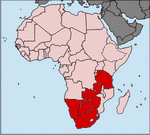 |
Distribution: Botswana, Namibia, South Africa, Tanzania, Zambia and Zimbabwe Coloration: Legs palpi and chelicerae beige/grey. Leg and palp joints are pale yellow. Carapace pale grey with golden radial striae (striae often absent or very fine). Dorsum of abdomen pale grey with dark pattern of bars, spots and reticulations. Sternum dark grey or black. Fovea: transverse Spermathecae: with single rounded terminal lobs (Figs. 117 Palpal bulb: pyriform with fine, evenly curved, acuminate embolus. Some specimens with pyriform bulge between embolus and tegulum. Keels absent along embolus (Figs. 111 Body length: male ~30mm, female ~40mm |
| Pterinochilus murinus POCOCK, 1897 | |
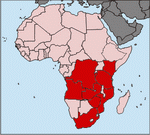 |
Distribution: Angola, Burundi, Tanzania, Dem. Rep. Congo (Zaire), Kenya, Mozambique, South Africa, Sambia and Simbabwe Coloration: Legs, palpi and chelicerae orange, beige or darkggrey/black depending of colouration variant. Leg and palp joints are pale yellow. Dorsum of abdomen with dark pattern of bars, spots and reticulations. Carapace dark with orange or yellow/golden striae (in some specimens carapace covered by setae obscuring radial pattern). Sternum and coxae black - general colouration can vary addicted on the colour variation. Fovea: deep, transverse Spermathecae: terminal parts curved inwards and without terminal lobs (Figs. 127 Palpal bulb: pyriform with filiform, mid-inflected, elongated, acuminate embolus. Keels absent along embolus (Fig. 122 Body length: male ~40mm, female ~50mm |
| Pterinochilus simoni BERLAND, 1917 | |
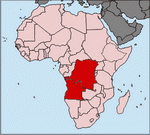 |
Distribution: Angola, Angola/Cabinda Province and Dem. Rep. Congo (Zaire) Coloration: Legs, palpi, abdomen and chelicerae chesnut brown. Leg and palp joints are pale yellow. Carapace and dorsum of trochanter are pale yellow. Dorsum of abdomen with dark pattern of bars, spots and reticulations. Sternum and coxae dark brown. Fovea: deep, transverse Spermathecae: with single rounded terminal lobs. Main body of spermathecae elongated (Figs. 138 Palpal bulb: pyriform with evenly curved, acuminate embolus. Keels absent along embolus (Figs. 131 Body length: male ~35mm, female ~35mm |
| Pterinochilus vorax POCOCK, 1897 (Type species) | |
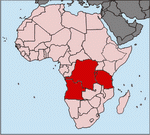 |
Distribution: Angola, Burundi, Dem. Rep. Congo (Zaire), Ruanda and Tanzania Coloration: Legs, palpi, abdomen and chelicerae brown. Leg and palp joints are pale yellow. Carapace brown with golden radial striae (striae often absent or very fine). Dark "mask" around the ocular tubercle. Dorsum of abdomen brown with dark pattern of bars, spots and reticulations. Sternum and coxae brown. Fovea: transverse Spermathecae: with single rounded terminal lobs (Figs. 149 Palpal bulb: pyriform, with flexed, acuminate embolus. Keels absent along embolus (Figs. 143 Body length: male ~30mm, female ~40mm |
In agreement with Richard GALLON we propose special terms for all the different colour variations of Pterinochilus murinus and Pterinochilus chordatus:
-
P. murinus TCF: typical colour form
Named after the colouration of the type, different pale beigecolouration, sometimes with a greenish sheen, long setae on legs and abdomen pale pink. -
P. murinus RCF: red colour form
Long and short setae red/orange, often sold as P. mamillatus or P. spp. "usambara" -
P. murinus UMV: Usambara Mountains variant
Probably a natural intergrade between TCF and RCF (but more close to TCF). Their coloration is more intensive yellow/pale orange than TCF. -
P. murinus DCF: dark colour form
Coloured general darkgrey, partial black. Carapace gold/yellow with dark radial striae - those are not as intensive as P. murinus TCF. Rarely seen and not in the hobby. The abdominal pattern are the same in all colour variations.
-
P. chordatus TCF: typical colour form
Named after the colouration of the type. Coloured general grey/brown, Radial striae on the carapace with gold or silver sheen. -
P. chordatus LCF: light colour form
Abdominal pattern similar to TCF. Coloured more pale grey/beige (similar to P. lugardi) -
P. chordatus DCF: dark colour form
Colouration prominent darker than in P. chordatus TCF, partial total black without any abdominal pattern or radial striae on the carapace. Rarely seen - not in the hobby.
The intenseness of the general colouration can vary depending on the moult-interval. Maybe the transitions between the different colouration variants are fluently and not stable.
Synonyms:
P. affinis TULLGREN, 1910 = P. chordatus (GERSTÄCKER, 1873)
P. brunellii CAPORIACCO, 1940 = P. chordatus (GERSTÄCKER, 1873)
P. carnivorus STRAND, 1917 = P. chordatus (GERSTÄCKER, 1873)
P. hindei HIRST, 1907 = P. murinus POCOCK, 1897
P. mamillatus STRAND, 1906 = P. murinus POCOCK, 1897
P. mutus STRAND, 1920 = P. simoni BERLAND, 1917
P. occidentalis STRAND, 1920 = P. simoni BERLAND, 1917
P. raptor STRAND, 1906 = P. chordatus (GERSTÄCKER, 1873)
P. sjostedti TULLGREN, 1910 = P. chordatus (GERSTÄCKER, 1873)
P. widenmanni STRAND, 1906 = P. chordatus (GERSTÄCKER, 1873)
P. breyeri HEWITT, 1919 = Augacephalus breyeri (HEWITT, 1919)
P. constrictus STRAND, 1907 = Eucratoscelus constrictus (GERSTÄCKER, 1873)
P. crassispinus PURCELL, 1902 = Idiothele nigrofulva (POCOCK, 1898)
P. junodi SIMON, 1904 = Augacephalus junodi (SIMON, 1904)
P. meridionalis HIRST, 1907 = Ceratogyrus meridionalis HIRST, 1907
P. nigrofulvus POCOCK, 1898 = Idiothele nigrofulva (POCOCK, 1898)
P. schoenlandi POCOCK, 1900 = Trichognathella schoenlandi POCOCK, 1900
P. spinifer POCOCK, 1898 = Eucratoscelus constrictus (GERSTÄCKER, 1873)
Coelogenium raveni (SMITH, 1990) = P. chordatus (GERSTÄCKER, 1873)
Eucratoscelus tenuitibialis (SCHMIDT & GELLING, 2000) = P. lugardi POCOCK, 1900
Harpactira chordata GERSTÄCKER, 1873 = P. chordatus (GERSTÄCKER, 1873)
Harpactira elevata KARSCH, 1878 = P. murinus POCOCK, 1897
Idiothele pluridentatus (HEWITT, 1919) = P. lugardi POCOCK, 1900
Pterinochilides obenbergeri STRAND, 1920 = P. simoni BERLAND, 191
Pterinochilides STRAND, 1920 = Pterinochilus POCOCK, 1897

